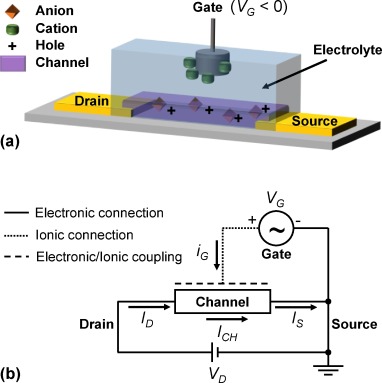Apr 30 2021
Organic Electrochemical Synaptic Transistor
 The title of this post should be provocative, if you think about it for a minute. For “organic” read flexible, soft, and biocompatible. An electrochemical synapse is essentially how mammalian brains work. So far we can be talking about a biological brain, but the last word, “transistor”, implies we are talking about a computer. This technology may represent the next step in artificial intelligence, developing a transistor that more closely resembles the functioning of the brain.
The title of this post should be provocative, if you think about it for a minute. For “organic” read flexible, soft, and biocompatible. An electrochemical synapse is essentially how mammalian brains work. So far we can be talking about a biological brain, but the last word, “transistor”, implies we are talking about a computer. This technology may represent the next step in artificial intelligence, developing a transistor that more closely resembles the functioning of the brain.
Let’s step back and talk about how brains and traditional computers work. A typical computer, such as the device you are likely using to read this post, has separate memory and logic. This means that there are components specifically for storing information, such as RAM (random-access memory), cache memory (fast memory that acts as a buffer between the processor and RAM) and for long-term storage hard drives and solid state drives. There are also separate components that perform logic functions to process information, such as the central CPU (central processing unit), graphics card, and other specialized processors.
The strength of computers is that they can perform some types of processing extremely fast, such as calculating with very large numbers. Memory is also very stable. You can store a billion word document and years later it will be unchanged. Try memorizing a billion words. The weakness of this architecture is that it is very energy intensive, largely because of the inefficiency of constantly having to transfer information from the memory components to the processing components. Processors are also very linear – they do one thing at a time. This is why more modern computers use multi-core processors, so they can have some limited multi-tasking.
Biological brains are very different. The logic components and the memory components are the same. In the human brain there are 10^11 neurons interconnected by 10^15 synapses. The synapses are electrochemical connections by which a signal goes from one cell to the next. Synaptic signals can either increase or decrease the likelihood of the next neuron firing, and the aggregate effect of many synapses from many neurons will determine if a neuron fires and how fast. The anatomy and chemistry of the synapse determines the strength of the connection, which is part of memory. And, when neurons fire with each other changes in the synapses reinforces those pathways, acting as a type of memory (which is the brain we also call plasticity). So the anatomy and physiology of the neurons and all their connections and synapses are both the memory and the information processing.
The strength of biological brains is that they are extremely efficient and use much less energy than computers. They also have massive parallel processing which allows for a lot of flexibility. Brains are therefore better at multi-tasking (although this does not apply to conscious attention, but we can walk and chew gum at the same time) and at unstructured tasks like pattern recognition. Their weakness is that memory is only metastable and can morph over time, and the brain uses complex processing for even simple tasks, so doing multiplication in your head is extremely slow compared to a calculator.
Computer scientists would therefore love to combine the best of both worlds, to build computers that function like biological brains and are also compatible with both biological brains and digital computers. The latest incarnation of this technology is the organic electrochemical synaptic transistor. This technology has actually been in development for years. A new study takes it one step further by demonstrating associative learning, which is key to the function of the human brain.
An organic electrochemical transistor (OECT) works by trapping ions, using them to communicate with each other like the neurotransmitters in the brain. The OECTs can also retain these signals so that they remember previous states, which acts as a form of long-term plasticity or memory. In the new study they connected OECTs into a “neuromorphic” circuit, which can change its state based upon activity. They gave it an associative task – they connected it to a light sensor and a pressure sensor. Whenever the LED light flashed and triggered the light sensor, they would also trigger the pressure sensor. Eventually the circuit remembered this association, and would automatically fire the pressure sensor after the light sensor was triggered.
This, of course, is a tiny step but it is a good proof of concept. The hope is that OECTs will be biocompatible, because they are flexible, use less energy than traditional computer chips, and function in a way similar to brain neurons. “Biocompatible” specifically is intended to mean that it is useful for brain-machine interface. The ultimate goal would be to create an implantable OECT-based computer chip into the brain that can safely function there and exchange information with the brain. If we can get this interface to work well, that would open a huge world of BMI technology, such as allowing people to control robotic limbs with their mind.
And of course, this kind of technology may be optimal for developing true general AI – artificial brains. We are still a long way away from this, but this technology is getting us closer.






